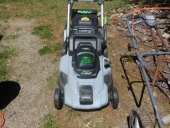posted 3 years ago
I could kick myself for not grabbing "broken" electric mowers from the side of the road. Some of the older ones had brushed motors, but most of the ones you can find now are brushless DC motors (BLDC). They have no brushes to wear out or fail prematurely from improper installation. The only things that can go wrong are the motor controller, which you can often find cheap replacements for, or something with the battery pack which usually isn't the entire pack gone bad and can be fixed or replaced for a fraction of the cost of a new pack.
I personally would hunt around on Craigslist or similar and find one for cheap or free to fix up. The chances of the motor itself being destroyed is insanely low, so if you can rotate it by hand and the bearings seem good then it is probably going to be good for a long time to come. Even if you pay $50 for a good chassis with the blade and motor, that's likely going to be much cheaper and easier than retrofitting a motor to an old chassis. Just getting the relationship of the motor, the blade, and the ground right is going to take a substantial amount of engineering that has already been accomplished on one that came electric from the factory. If it comes with a working charger then you are that much ahead. If the charger is bad then maybe that's all it needs to get going!
I'm really not a fan of the nomenclature used on various tools to describe their "voltage". Most of them use Lithium Ion 18650 cells in a series-parallel configuration. Knowing the number of cells in series is the important part so the motor controller won't prematurely shut off with an input voltage that's too low, or blow up capacitors (or worse) with too high an input voltage. There are certain numbers of cells in series which are more common, so you would likely want to target one of these common "sizes" or "voltages" which would be easier if tools didn't fudge their voltage numbers differently than other implementations of Lithium Ion cells. It should be simple enough to do a search online to see what the exact details are for any mass produced machine you might find for sale.
One point that is noteworthy is that you can always run a BLDC motor at a lower voltage than maximum if you get an appropriate motor controller. My fat bike was originally 13s "48V" and I had a spare 10s "36V" controller that fit in the original compartment. The top speed is slightly reduced and probably a fair bit less torque, but it rides fine. Since I had everything on hand I had the bike rebuilt and running in one weekend. This would be particularly useful if, for instance, you find a less common size like a 14s and have batteries and controllers for the more common 13s. The small drop in voltage by decreasing the power by one cell in series shouldn't kill performance. By building a higher amperage pack (more cells in parallel) there will be less voltage drop under load, and may be comparable to the running voltage of the stock setup. You can go the other way and overvolt things, but that has a much higher probability of burning out a motor or controller if you aren't careful. In either case, it's probably wise to add replaceable fuse close to the battery that is smaller than the maximum safe output from the battery pack or Battery Management System (BMS).
For me, I already had invested in "36V" (10s or 10 cells in series, 42V max) for my electric bike, so it was an obvious choice to go with a "40V" Ryobi when it was on sale. Like I said, I could kick myself for riding around after I first built the bike and not stopping to grab a handful of electric mowers I had seen at the curb on garbage day. The battery is the most complex and expensive part, so once you get a good grasp on that, you can save yourself quite a bit of money and reuse good cells that are otherwise sitting in a warehouse, waiting for legislation to force them to be recycled before they were ever even used!


 2
2








 2
2





















 1
1




















 4
4




 6
6




 2
2




![Filename: Sheep.jpg
Description: [Thumbnail for Sheep.jpg]](/t/66146/a/189089/Sheep.jpg)








